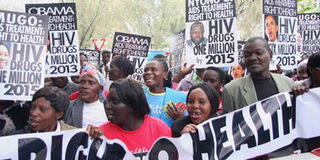Cheserem team lays bare counties hardest hit by Aids epidemic

PHOTO | FILE Activists and people living with Aids demonstrate in Nairobi in April 2012, to demand that the government allocates more money for Aids treatment. Nairobi has the highest number of HIV cases, followed by Homa Bay.
Nairobi, Kisumu and Homa Bay have the greatest Aids burden in the country, according to the first ever government ranking of selected social indicators in counties.
A new report by the Commission for Revenue Allocation shows that 199,100 people are living with Aids in Nairobi county, the highest number in the country. The prevalence rate stands at 8.6 per cent, much higher than the national average, according to the report.
Nationally, the HIV prevalence rate — the proportion of adults aged 15 years and above who were infected in 2011 — was 6.2 per cent, according to the Kenya Aids Epidemic update 2012 Report released early this year.
According to the Kenya County Fact Sheets dated June 2013, Nairobi had 13,510 new HIV infections in 2011, the highest among all the 47 counties, presenting a daunting task to the devolved government led by Governor Evans Kidero.
The report also exposes massive disparities in counties in poverty, access to water, electricity and education levels.
Next to Nairobi, the Kenya County Fact Sheets report lists Kisumu, Homa Bay, Siaya and Mombasa as the counties that are home to the highest number of people living with Aids.
Aids burden
Homa Bay has 150,000 people living with HIV, making the county the worst carrier of the Aids burden, at position 46. It had 9,500 new infections in 2011 while its prevalence rate was 27.1, four times above the national average.
At position 45 — third from bottom — Kisumu had 113,000 people living with the virus. It had a prevalence rate of 18.7 per cent, more than three times the national average. There were 7,100 new infections in the country in 2011 alone.
Neighbouring Siaya has 100,400 people living with the disease and was number 44 among all counties. In 2011, it had a prevalence rate of 17.8, nearly three times the national average. It had 6,300 new infections that year.
Mombasa county is the fifth among the hardest hit counties with 77,100 people living with Aids. The county recorded 4,930 new infections in 2011. It was followed by Kisii county (41), which has 73,300 people living with the virus.
According to the report, Wajir — with only 800 people living with Aids — has the least burden of the condition. There were only 10 new infections in 2011. The prevalence rates was only 0.2, far lower than the national average.
Lamu county at the Coast region had the second fewest cases of people living with HIV: 800. It also recorded the least number of new infections (10), the same as Wajir. Marsabit, with 1,700 people, was third. It had 460 people who were infected by the virus in 2011.
Mandera was fourth with 7,900 cases, followed by Isiolo with 3,200. Data on HIV was generated from various surveillance reports, surveys and census projections.
Other than health, the report also provides crucial data on other social aspects including poverty, education, water and sanitation.
“Data on education and health, water and sanitation, access to electricity and the road network all tell the story of historical inequities,” the report said. The disparities show “the failure of a centralised state to equalise opportunities for all Kenyans”.
According to the report, Kenyans have embraced devolution because they expect that it will help fill these service delivery gaps.
“Tracking county performance over time on these indicators will provide a good measure of the extent to which the constitutional promise had been met,” the report says and calls good performers to be identified to generate lessons for others.
Commission for Revenue Allocation chairman Micah Cheserem said it was the first time that any report has released county-specific data on HIV/Aids and other health challenges.
“No other single book has ever attempted to provide county-specific data in such manner,” Mr Cheserem says in the report’s forward.
In its first such but smaller-in-scope booklet last year, the commission listed Kajiado as the richest county while Turkana was classified as the poorest.



